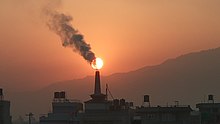Foam food container

A foam food container is a form of
Construction and composition
Foam take-out containers are made from
EPS foam is sometimes incorrectly called
Another trade name for EPS is thermacol, originated by BASF.
Varieties
The different varieties of foam takeout containers may include:
- A rectangular shaped clamshell style container with an attached lid, which comes in various sizes. The larger ones usually feature several compartments, allowing different foods to be kept separated from each other. This variety usually features several small projections on the lid of the container, which fit through slots on the bottom half to "lock" it, therefore keeping the cover closed. These containers are leak-resistant only if kept upright, and often have a square imprint area for labeling.
- A cylindrical style container with a separate, translucent or opaque plastic lid which can seal tightly to resist leaks. The container may or may not taper somewhat towards the bottom. Both overall size and the ratio of height to diameter can vary greatly. Such containers usually hold soups and stews; however, smaller varieties are often used to hold sauces and condiments.
Chinese cuisine
Foam containers are the most commonly used takeout box for Chinese cuisines in East and Southeast Asia. It is standard for Cantonese cuisine in Hong Kong and many parts of China and sometimes used overseas in various restaurants, particularly in the United States and Canada.
Environmental issues
| Part of a series on |
| Pollution |
|---|
 |
Foam takeout containers entirely made out of polystyrene foam affect the environment as they do not
Health issues
According to American Cancer society the use of polystyrene is safe for food services .[11]
Styrene is considered by both the EPA and IARC to be a possible carcinogen.[12][13] It poses a health risk to workers involved in the production of styrene and polystyrene items, and industries have a compliance program to deal with liabilities.[14][unreliable source?] Prolonged exposure to high amounts of styrene may affect the central nervous system.[15]
See also
References
- ^ Stevens, Laura (11 April 2014). "There's No Such Thing as a Styrofoam Cup". Wall Street Journal. Retrieved 21 November 2017.
- ^ "Polystyrene Foam Report". Earth Resource Foundation. Archived from the original on 25 March 2013. Retrieved 20 March 2013.
- ^ "Deep Geologic Repository Project". ceaa-acee.gc.ca. Retrieved 1 February 2023.
- ^ Roy, Robert (2006-03-07). "Immortal Polystyrene Foam Meets its Enemy". LiveScience. Retrieved 2018-04-16.
- PMID 16649270.
- ^ "San Francisco Bans Styrofoam for To-Go Containers". treehugger.com. Archived from the original on 2009-03-04. Retrieved 2009-03-18.
- ^ "Seattle Styrofoam Ban Leads to Packaging Changes". Sustainableisgood.com. 2010-07-06. Retrieved 2018-04-16.
- ^ "City of Portland Garbage and Recycling Rules and Regulations". Portlandonline.com. Retrieved 2018-04-16.
- ^ Grynbaum, Michael M. (February 13, 2013). "To Go: Plastic-Foam Containers, if the Mayor Gets His Way". New York Times. Retrieved 20 March 2013.
- ^ Ferré-Sadurní, Luis (23 December 2019). "New York State Moves to Ban Foam Food Container". New York Times. Retrieved 25 December 2019.
- ^ "Microwaving food in plastic: Dangerous or not?" Archived 2015-01-07 at the Wayback Machine
- ^ "epa.gov" (PDF). epa.gov. 2018-04-03. Retrieved 2018-04-16.
- ^ "inchem.org". inchem.org. 2002-12-04. Retrieved 2018-04-16.
- ^ "Polystyrene Foam Report". Earth Resource Foundation. Archived from the original on 25 March 2013. Retrieved 18 August 2015.
- PMID 8823057.
